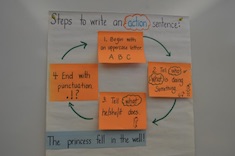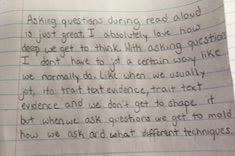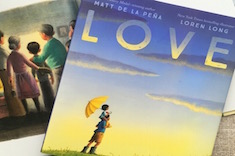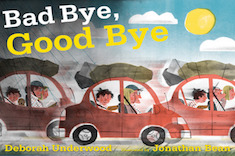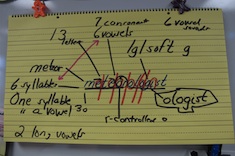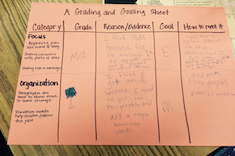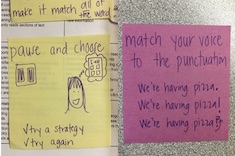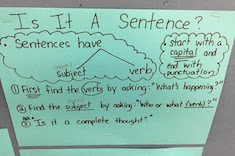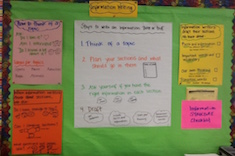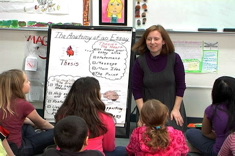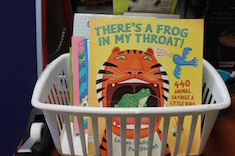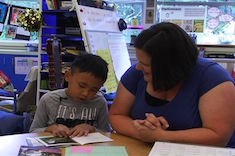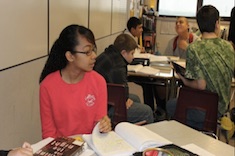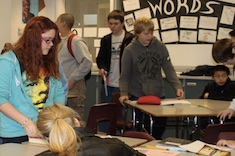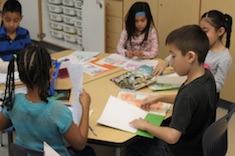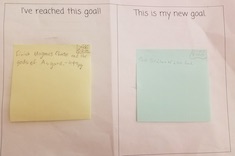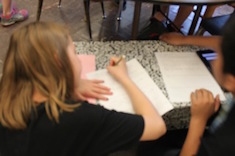Articles
Here is where you’ll find all the latest print features from our contributors. If you’d like to browse specifically by grade level, topic, or contributor, you can use the links in the right sidebar.
Latest Content
Eating Poetry
April is a month-long “thanksgiving” for those of us who love poetry. Shirl McPhillips shares her favorite resources for sharing that love with students.
Spoken Word Poetry
Gretchen Schroeder uses online videos as resources to teach her high school students to appreciate spoken-word poetry and write their own.
Forest Bathing
Shirl McPhillips explains how "forest bathing" is a wonderful entry point for writing, especially in early spring.
Inspiring Students to Revise
Melanie Meehan uses revision strips to move young writers beyond "I'm done!" and into expanding and editing their writing.
Choose Your Own Grammar Adventure
Gretchen Schroeder shares a quick exercise she’s developed for her high school students to hone grammar and editing skills using online video resources and individual Chromebooks.
How to Write a Sentence
Bitsy Parks realizes charts will help her first graders craft sentences. She shares how her sentence writing charts have changed over time.
Questioning Within Read Alouds
Melanie Meehan looks at the issue of engagement through the lens of student questions during read alouds, and shares a strategy to provoke more thoughtful student participation.
Leveraging Read Aloud
Christy Rush-Levine finds that administrators are questioning the value of read alouds, especially with older students. She shares how she uses the picture book Love in her middle school classroom to launch challenging discussions about timely themes.
End-of-Year Read Alouds
Bitsy Parks explains how the ending weeks of read alouds in her first-grade classroom are designed to celebrate learning and shared experiences from the entire year.
Building Stronger Wordsmiths
Maria Caplin is integrating vocabulary work into content areas.
Meaningful Data
Ruth Ayres explains how data can make students and teachers feel empowered or deflated—so much depends on what you are looking for and how you present it.
Asking Students to Grade Themselves
Asking students to assess and grade their own work cements learning and deepens understanding for many students, but only if it is done in a thoughtful, collaborative way. Melanie Meehan takes you step-by-step through the process in a fifth-grade classroom.
Leveraging Reading Assessment Benchmarks
Benchmark assessments can be incredibly time-consuming for teachers to complete. Tara Barnett and Kate Mills describe how they leverage the time spent by using the assessments in strategy conferences with students.
An Editing Strategy for Run-On Sentences
Is your problem writers whose sentences never seem to end? Tara Barnett and Kate Mills have a strategy for grappling with run-on sentences.
Bulletin Board of Independence
Melanie Meehan uses independence bulletin boards to provide students with options when working on their own during units of study.
Writing Workshop Bingo
Carly Ulmer develops a bingo board to use with her middle school students to give them more choice and foster independence while crafting writing in specific genres.
Students Watching Teachers
Students are always watching us, whether we realize it or not. Jennifer Schwanke explains how we can capitalize on that interest to build independent reading and writing habits.
One Text, Many Lessons
Tara Barnett and Kate Mills share how one book can serve as an anchor for lessons on everything from writer’s craft to test-taking skills.
Keeping Minilessons Short
Melanie Meehan gives three quick management tips for tackling the challenge many teachers face — keeping minilessons short.
Revising Thinking Through Multiple Readings
We’ve all had that student — the one who blurts out a misreading of a text, only to have classmates agree with the analysis. Christy Rush-Levine explains how she uses “first-, second-, and third-draft readings” to help her middle school students develop stronger comprehension skills.
Questions for Rereaders
Lifelong readers often have books they love to reread, sometimes more than once. But young readers can also get into ruts. Jennifer Schwanke explores when rereading is fine for students, and when it should be challenged. She includes a series of questions for teachers to use when conferring with children who are rereading favorite books.
Fostering More Rereading in Classrooms
Stella Villalba explains why rereading is especially useful for young English language learners, and shares some simple strategies for integrating more rereading strategies into reading and writing workshops
Bin of the Week
Shari Frost and a teacher she is assisting notice some bins collecting dust in the classroom library. When the teacher resists removing the books, they work together to find creative ways to help students develop enthusiasm for neglected series and authors.
Why Bother? Practical Answers to Questions About Close Reading
Why bother with close reading? Jennifer Schwanke finds many teachers asking themselves if close reading is worth the time, when schedules are already overstuffed. She shares some prompts to help assess when close reading makes sense.
Stop and Inquire
Mark Levine capitalizes on what captures his middle school students’ attention with his Stop and Inquire routine.
Flash Forward with New Students
The dark days of winter may be the best time to plan for spring step-up events to introduce students to next year's teachers. Christy Rush-Levine has a new goal of using the day to promote summer reading.
Goals to Habits in First Grade
Bitsy Parks finds goals aren’t enough for her first-grade students—real growth requires that the goals eventually become habits. She develops a process mid-year to help children refine their goals step-by-step.
Goals in Small Groups for English Language Learners
Setting small-group goals can be tricky, and the complexity is compounded when you are working with English language learners. Kate Mills explains her goal-setting process with K-3 ELLs, and gives examples of how it works.
Self-Assessment and Goal Setting
Gigi McAllister is disappointed by the shallow and unexpected responses by her fourth graders to literacy rubrics at the end of the year. The experience sends her on a quest to do a better job of helping her students learn to set goals and understand what measurable progress looks like over time.
Independence in Writing Workshop
What's the difference between a sense of calm purpose in writing workshops and an atmosphere fraught with tension? Tara Smith finds in her sixth-grade classroom it's the structures in place (or missing) for student independence.
Browse Content By
Type
Category
- Assessment Tools
- Big Fresh Archives
- Booklists
- Choice Numeracy
- Classroom Design
- Common Core
- Community Building
- Conferring
- Content Literacy
- Digital Literacy
- English Language Learners
- Equity
- Family Relations
- Free Samples
- Guiding Groups
- Leadership
- Literacy Coaches
- Mentor Texts
- Minilessons
- New Teacher Mentors
- Podcasts
- Poetry
- Quote Collections
- Reading Strategies
- Self Care
- Struggling and Striving Learners
- Talking and Listening
- Teacher Study Groups
- Teaching Reading
- Teaching Writing
- Word Study and Vocabulary
Author
- Melissa Quimby
- Nawal Qarooni
- Gwen Blumberg
- Julie Cox
- The Lead Learners
- Hannah Tills
- Josie Stewart
- Ruth Metcalfe
- Mallory Messenger
- Becca Burk
- Jodie Bailey
- Vivian Chen
- Mary Brower
- Tiffany Abbott Fuller
- Stephanie Affinito
- Ruth Ayres
- Leigh Anne Eck
- Heather Fisher
- Shari Frost
- Julie Johnson
- Suzy Kaback
- Gigi McAllister
- Shirl McPhillips
- Melanie Meehan
- Cathy Mere
- Debbie Miller
- Tara Barnett and Kate Mills
- Tammy Mulligan
- Dana Murphy
- Bitsy Parks
- David Pittman
- Brenda Power
- Heather Rader
- Matt Renwick
- Mandy Robek
- Christy Rush-Levine
- Gretchen Schroeder
- Jen Schwanke
- Brian Sepe
- Katherine Sokolowski
- Stella Villalba
- Jennifer Vincent
Grade Level
Choice Literacy Membership
Articles
Get full access to all Choice Literacy article content
Videos
Get full access to all Choice Literacy video content
Courses
Access Choice Literacy course curriculum and training






